America’s 5 Best and Worst Cities for Lung Health
Written by Karen Selby, RN • Edited By Walter Pacheco
Asbestos.com is the nation’s most trusted mesothelioma resource
The Mesothelioma Center at Asbestos.com has provided patients and their loved ones the most updated and reliable information on mesothelioma and asbestos exposure since 2006.
Our team of Patient Advocates includes a medical doctor, a registered nurse, health services administrators, veterans, VA-accredited Claims Agents, an oncology patient navigator and hospice care expert. Their combined expertise means we help any mesothelioma patient or loved one through every step of their cancer journey.
More than 30 contributors, including mesothelioma doctors, survivors, health care professionals and other experts, have peer-reviewed our website and written unique research-driven articles to ensure you get the highest-quality medical and health information.
About The Mesothelioma Center at Asbestos.com
- Assisting mesothelioma patients and their loved ones since 2006.
- Helps more than 50% of mesothelioma patients diagnosed annually in the U.S.
- A+ rating from the Better Business Bureau.
- 5-star reviewed mesothelioma and support organization.
Testimonials
My family has only the highest compliment for the assistance and support that we received from The Mesothelioma Center. This is a staff of compassionate and knowledgeable individuals who respect what your family is experiencing and who go the extra mile to make an unfortunate diagnosis less stressful. Information and assistance were provided by The Mesothelioma Center at no cost to our family.LashawnMesothelioma patient’s daughter
How to Cite Asbestos.com’s Article
APA
Selby, K. (2024, February 2). America’s 5 Best and Worst Cities for Lung Health. Asbestos.com. Retrieved April 16, 2024, from https://www.asbestos.com/mesothelioma/related-diseases/best-cities-for-lung-health/
MLA
Selby, Karen. "America’s 5 Best and Worst Cities for Lung Health." Asbestos.com, 2 Feb 2024, https://www.asbestos.com/mesothelioma/related-diseases/best-cities-for-lung-health/.
Chicago
Selby, Karen. "America’s 5 Best and Worst Cities for Lung Health." Asbestos.com. Last modified February 2, 2024. https://www.asbestos.com/mesothelioma/related-diseases/best-cities-for-lung-health/.
Stepping outside your front door to take a deep breath of fresh air sounds like a simple thing to do. Yet, between air pollution, chronic preexisting conditions and infectious diseases such as COVID-19, that deep breath may not be as healthy as it used to be.
Determining the best places to live for clean breathing and the cities with the biggest challenges for lung health will allow you to better understand how your hometown can impact your long-term health. We researched the overall impact of air pollutants on each city, the percentage of residents who currently smoke, the prevalence of lung and bronchus cancers and both asbestos-related deaths and COVID-19 mortality stats to create this list.
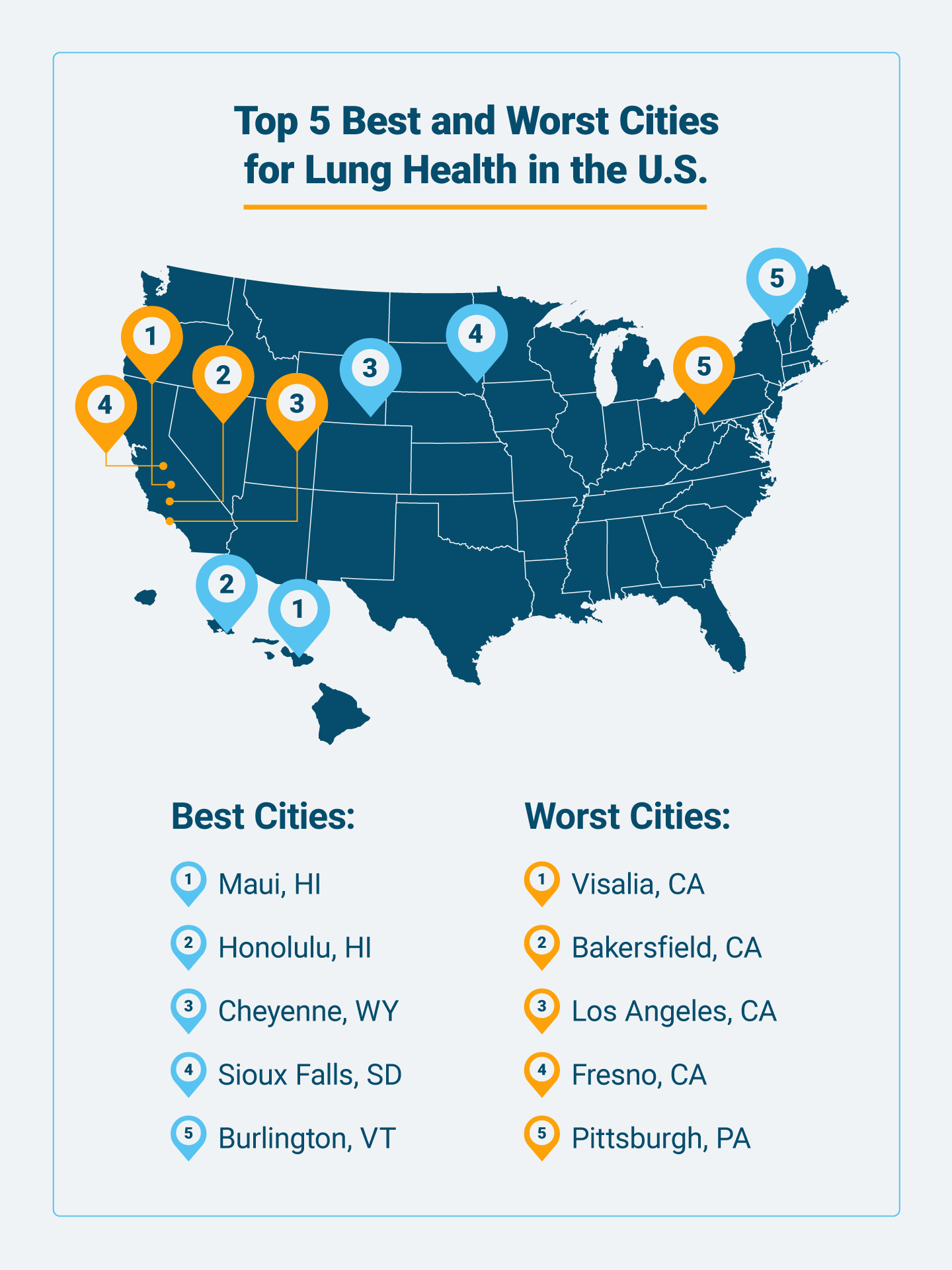
Why Lung Health Matters
While lung health may not be top of mind for most people, every cell in the human body requires oxygen to function. Our lungs process the air we breathe to move that oxygen throughout our bodies and, in turn, expel the waste gas (carbon dioxide) our bodies create. Environmental factors, disease and genetics can cause respiratory issues and directly impact the health of your lungs.
Everyday life can quickly become challenging and decrease in quality for those living with lung health issues. These issues can also cause premature death through increased risks of asthma, chronic obstructive pulmonary disease (COPD), mesothelioma and lung cancer.
Factors Influencing Lung Health
To identify the five best and five worst cities for lung health, our research team focused on the top 50 cities recognized for their air particle pollution rates — 25 of the cleanest and 25 of the most polluted — in the American Lung Association’s 2021 State of the Air report, then analyzed the following additional metrics for each city. These data points were selected as important factors in determining overall geographical lung health levels:
- Annual air particle pollution rates
- Percentage of current adult smokers over 18
- Average annual count of lung and bronchus cancer cases per capita
- State rank for asbestos-related deaths
- Number of COVID-19 deaths per capita
Smoking cigarettes has long been identified as the country’s leading cause of preventable disease and death, and is responsible for over 480,000 deaths each year. It is a known cause of cancers such as lung and bronchus, lung diseases and COPD, which includes emphysema and chronic bronchitis. At present, more than 16 million Americans live with a disease caused by smoking, with 58 million nonsmokers exposed to secondhand smoke.
Extended exposure to inhalation or ingestion of microscopic asbestos fibers can lead to major health impacts such as asbestosis, lung cancer and mesothelioma. Workplace exposure to asbestos is the No. 1 cause of asbestos-related disease.
As the COVID-19 pandemic continues, new research reveals that breathing polluted air over an extended period of time can amplify the effects of COVID on the body, leading to long-term health problems and death.
Observing these factors all together provides a clear portrait of America’s best and worst cities for lung health.
Best Cities for Healthy Lungs

1. Maui, HI
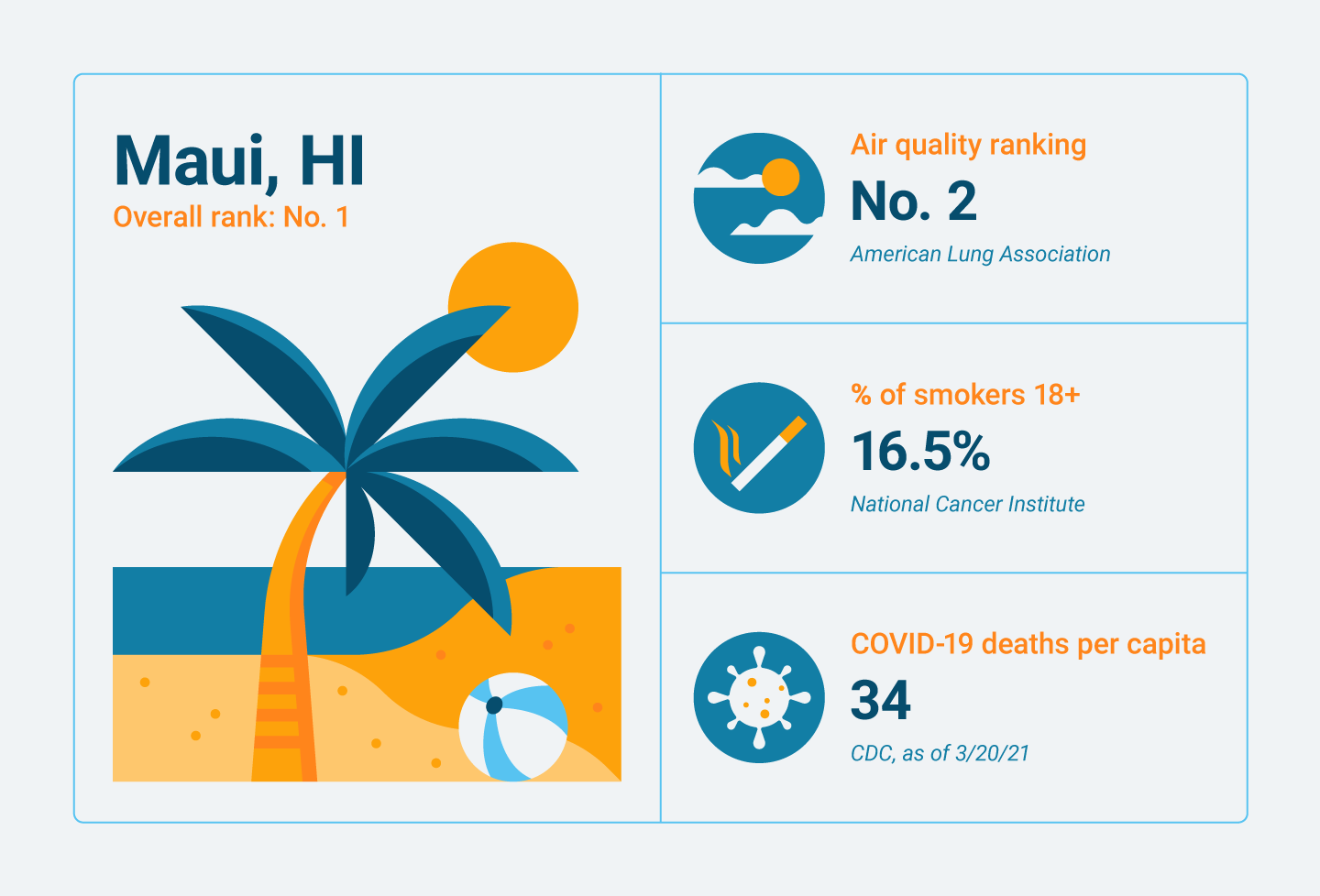
The No. 1 spot on our list goes to the Kahului-Wailuku-Lahaina metropolitan statistical area on the island of Maui in Hawaii, voted among the top two “Best Islands in the U.S.” for over 20 years by Condé Nast Traveler magazine. The stunning beaches bring fresh ocean breezes, helping to create air quality that ranked second highest among the contenders on our list. In close competition with Honolulu for the top spot on this list, Maui’s rank as No. 2 for fewest COVID deaths per capita was the differentiator.
2. Honolulu, HI
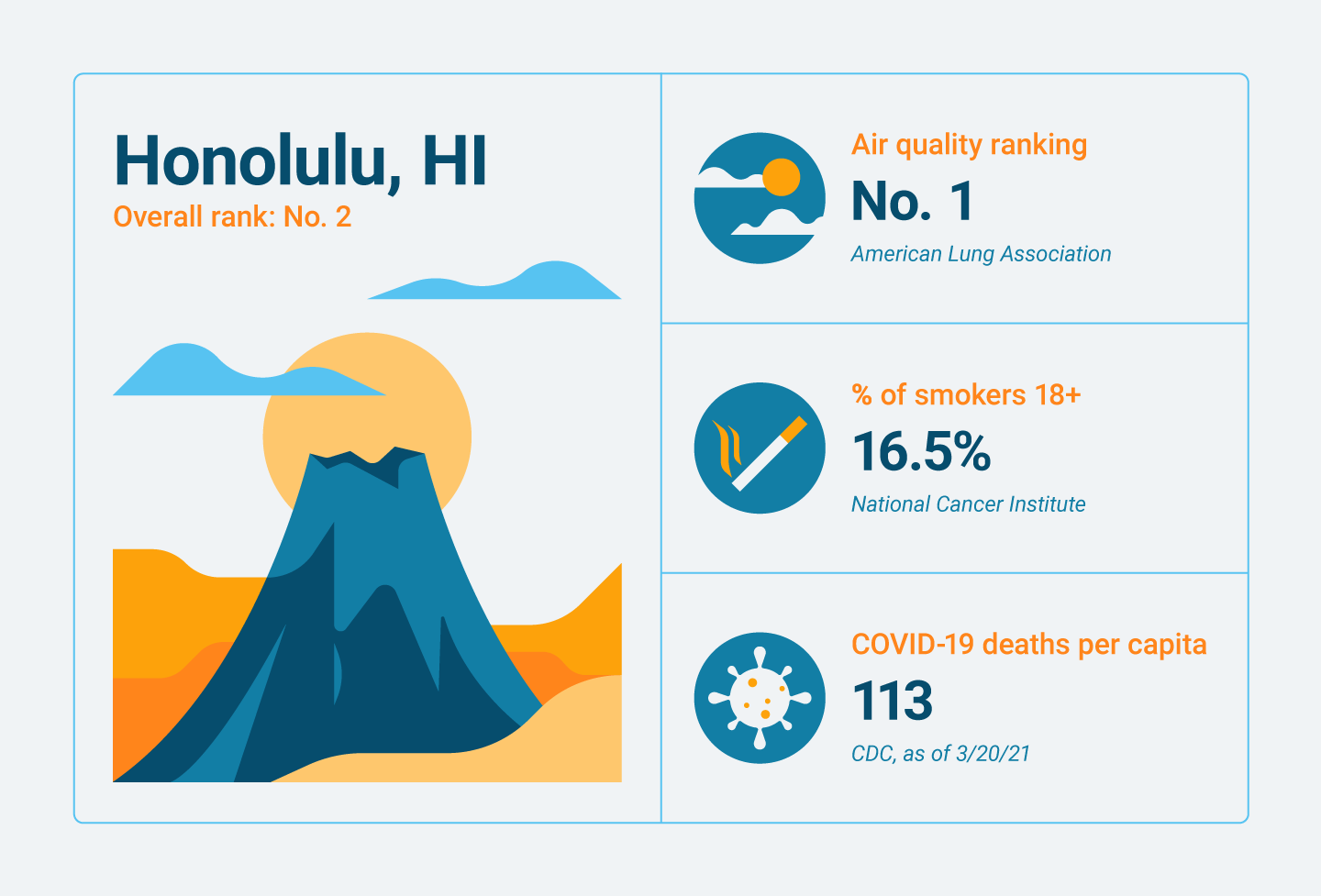
Honolulu was ranked the No. 1 cleanest city for year-round particle pollution by the American Lung Association. Sandy beaches, a bustling metropolitan area and fresh ocean air help make breathing easy there. The city also boasts the lowest number of lung and bronchus cancer cases per capita with under five cases per 100,000 residents.
3. Cheyenne, WY
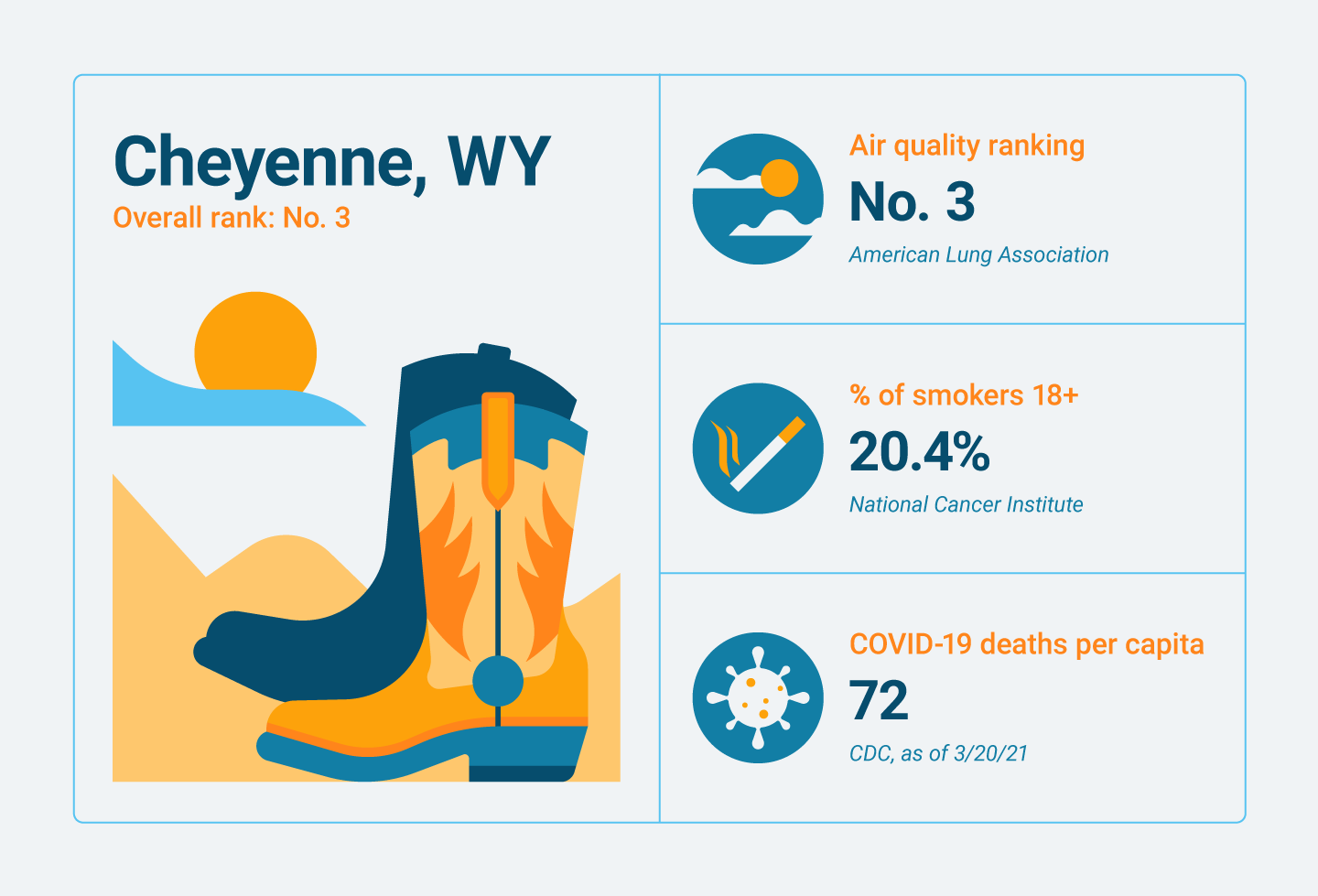
People living with lung health issues such as asthma or asbestosis can enjoy the clean air of Wyoming’s capital city, Cheyenne. Ranked No. 1 for the least amount of asbestos-related deaths and No. 3 for overall air quality on our list, the city offers a blend of the Old West and a modern metropolis.
4. Sioux Falls, SD
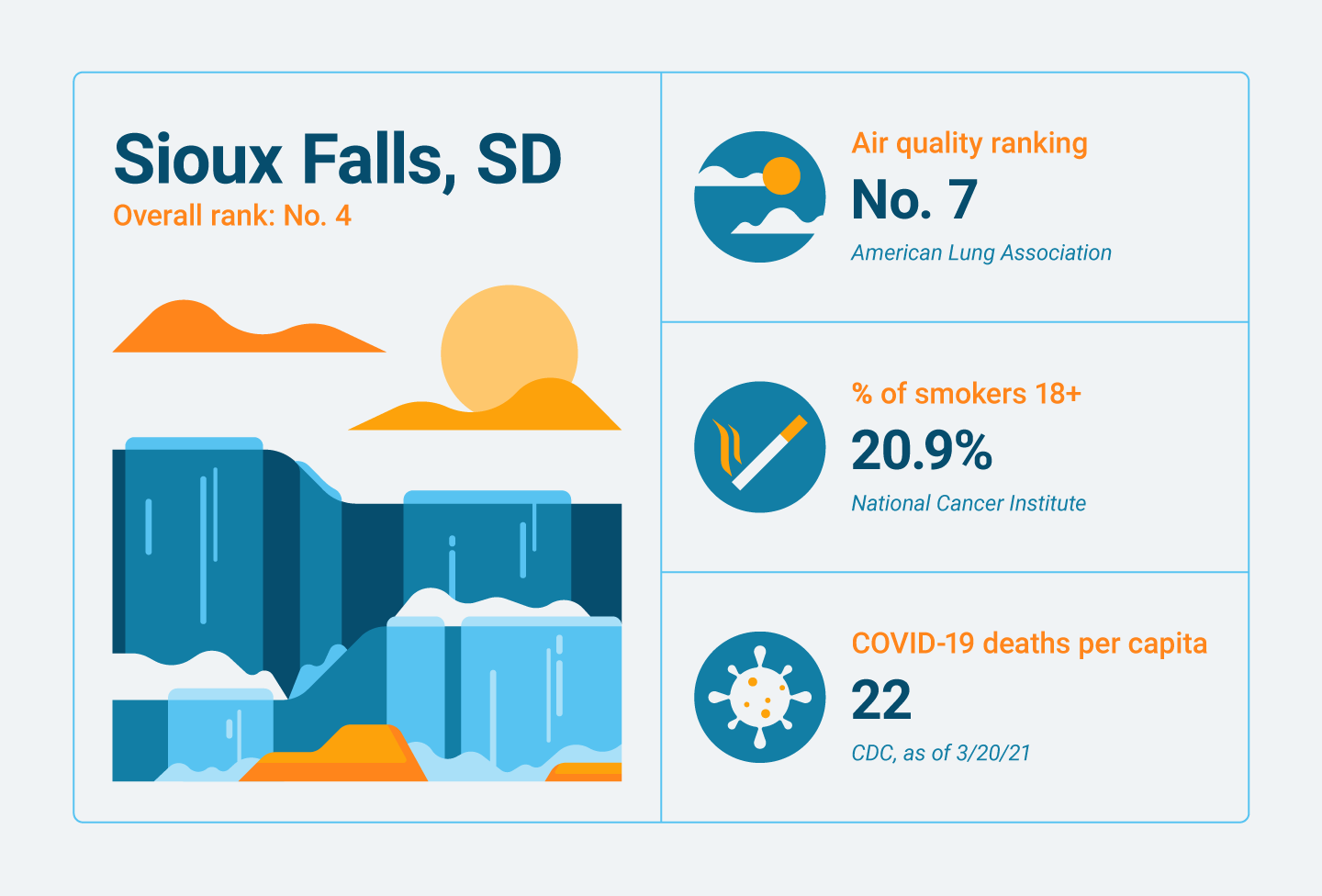
Good lung health is a clear priority for residents of this city, evidenced by Sioux Falls’ spot in the No. 1 and No. 2 positions for the smallest number of COVID deaths and lung cancer cases, respectively. The city of Sioux Falls in South Dakota provides ample opportunities for fresh air adventures, with the Big Sioux River running through town and its eponymous Falls Park.
5. Burlington, VT
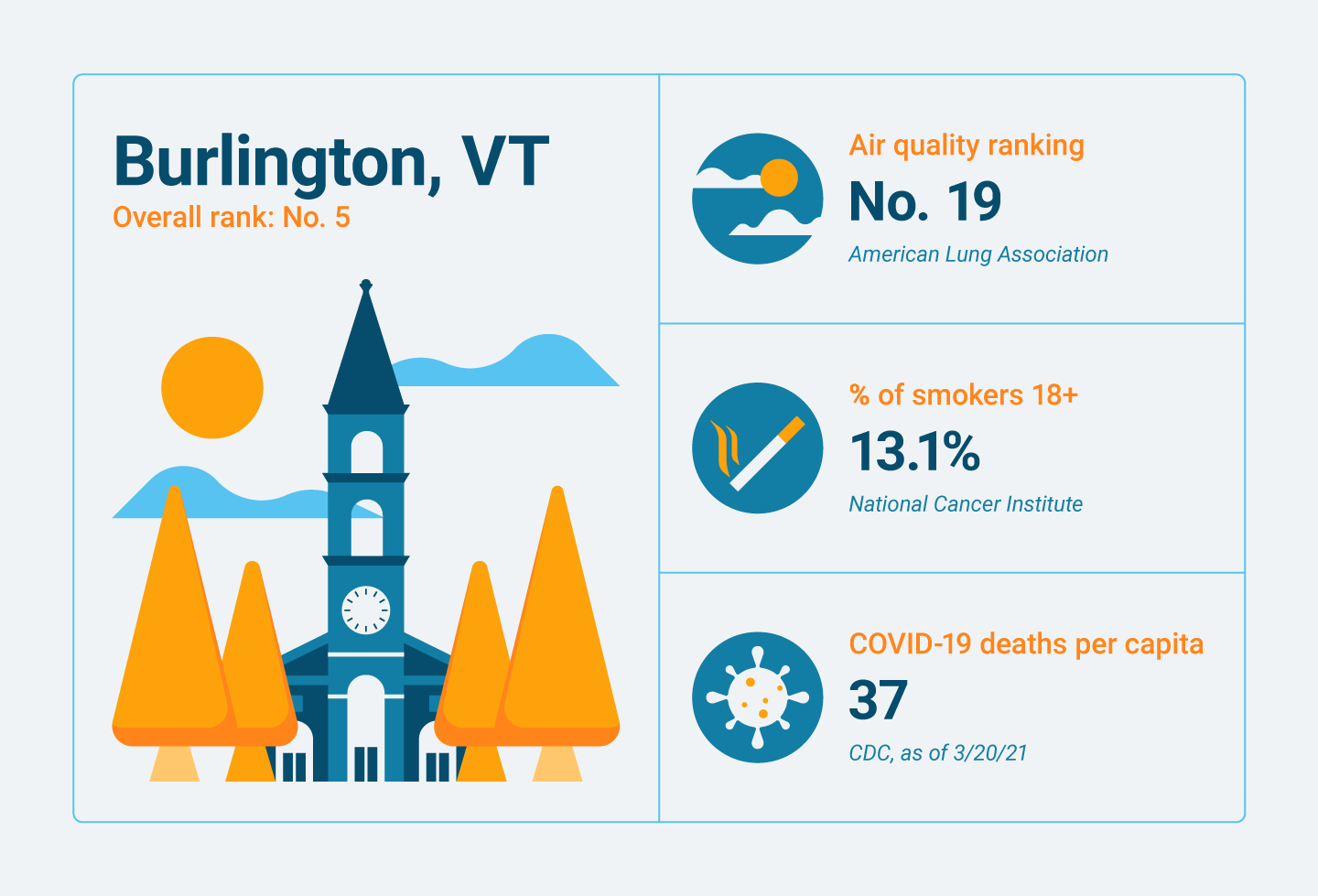
Situated on the eastern shore of Lake Champlain near the Canadian border, Burlington, Vermont, boasts the lowest percentage of adult smokers from the cities on our list at only 13%. The city offers a blend of New England charm and the natural wonders of the lake and nearby Green Mountains. Its decreased lung health risks are clear from the low number of COVID deaths they’ve experienced.
Worst Cities for Healthy Lungs

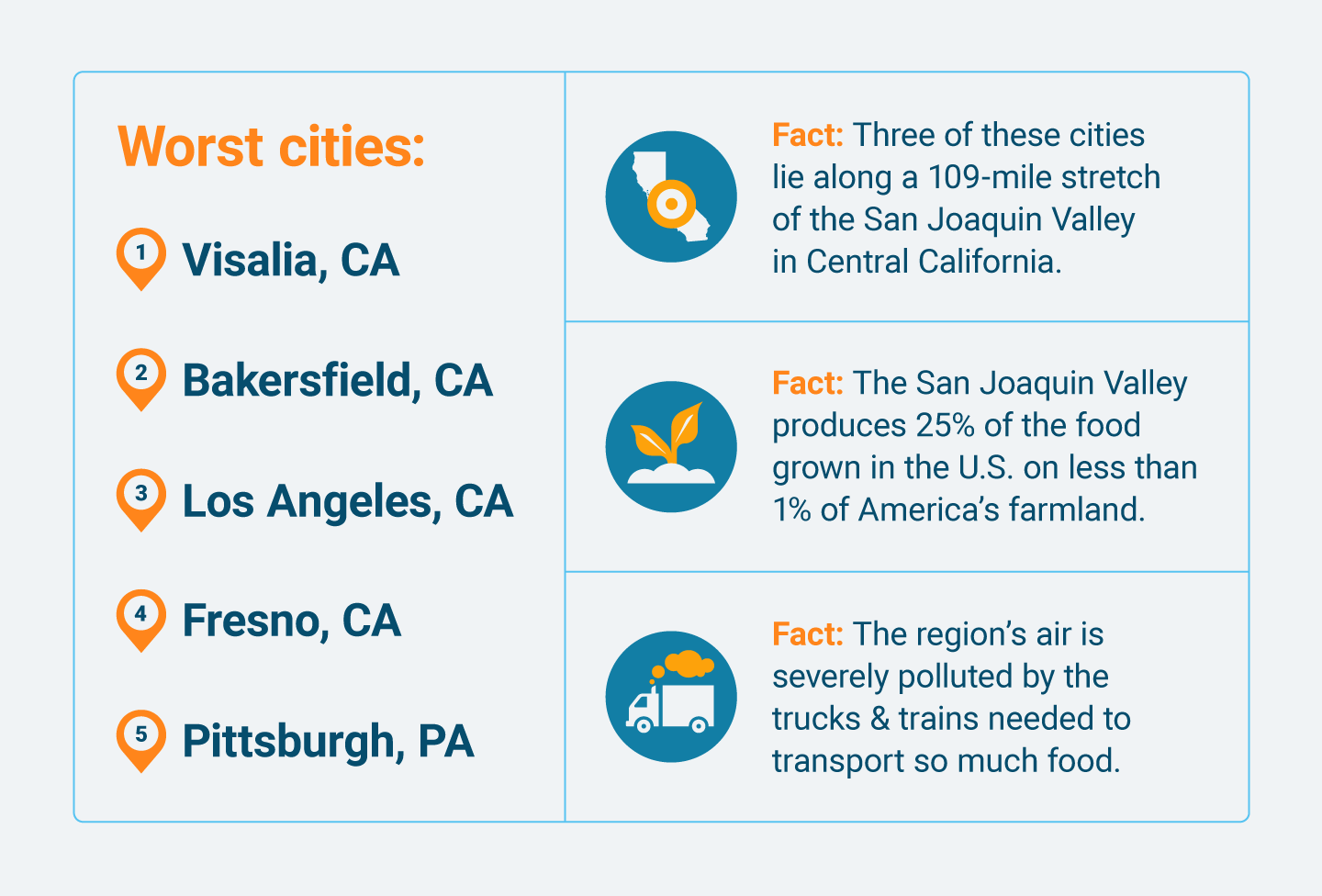
The state of California leads the unfortunate pack of cities on our worst cities for lung health list, with four of the top five. These results align with the same four cities ranking (in a slightly different order) as the top four most polluted cities, according to the American Lung Association’s 2021 State of the Air report. The Pennsylvania city of Pittsburgh rounds out the list, ranked No. 5 with a high volume of smokers and air contaminants from heavy industry and power plants.
- Visalia, CA
- Bakersfield, CA
- Los Angeles, CA
- Fresno, CA
- Pittsburgh, PA
The past five years have seen some of the deadliest and most destructive wildfires in California history. The intense severity, extended duration and increased frequency of these fires have dramatically contributed to the elevated air pollution experienced year-round across the state.
Three of the top five cities — Visalia, Bakersfield and Fresno — align in a heavily polluted 109-mile stretch of Central California along state Route 99. The region, also known as the San Joaquin Valley, has a topography of surrounding mountain ranges which trap air pollutants from the heavy traffic of trucks and other vehicles along Interstate 5 and Route 99.
This area is also a base for heavy agricultural production, using less than 1% of U.S. farmland to supply one-fourth of the entire country’s food, including 40% of America’s fruits, nuts and other table foods. The tractors, irrigation equipment and additional railway traffic needed to produce and transport this volume of food contributes to pollution issues.
The small city of Visalia, nestled between Fresno and Bakersfield, topped our overall list in part due to the shockingly high number of deaths from both lung cancer and COVID. It ranked No. 2 for both categories in our analysis.
If you’ve ever been to No. 3-ranking Los Angeles, you may have noted the heavy, hazy brown layer of pollution that hovers over the major metropolitan area. The problem existed prior to the recent increase in wildfires, in part due to 40% of all American imports funneling through the Port of Los Angeles and the Port of Long Beach. The trucking and railway transportation required to move all of those imports out of the ports’ ships and warehouses is a major contributor to LA’s poor air quality.
Lung and respiratory issues from conditions like COPD and pleural mesothelioma can have a drastic impact on your quality of life. Identifying the ideal and the not-so-ideal cities for optimum lung health creates a knowledge base that allows you to manage your overall health in your hometown.
Methodology:
To identify the best and worst cities for lung health in America, we compared data from the top 50 cities identified as having the best and worst air particulate concentration levels. We ranked each city on a weighted scale based on the following standards:
- Annual air particle pollution rates — 30 points
- Percentage of current adult smokers over 18 — 20 points
- Average annual count of lung and bronchus cancers per capita — 20 points
- State rank for asbestos-related deaths — 20 points
- Number of COVID-19 deaths per capita — 10 points
We collected data from the American Lung Association’s 2021 State of the Air report on the top 25 cities with the cleanest annual air particle pollution rates and the top 25 cities with the worst rates. We then looked at the National Cancer Institute’s numbers on current smoking prevalence among adults over 18 and its stats on per capita incidences of lung and bronchus cancer rates over a five-year period. We used our own scientifically reviewed state rankings of asbestos-related deaths, and added in current COVID-19 deaths per capita totals from the Centers for Disease Control and Prevention.







